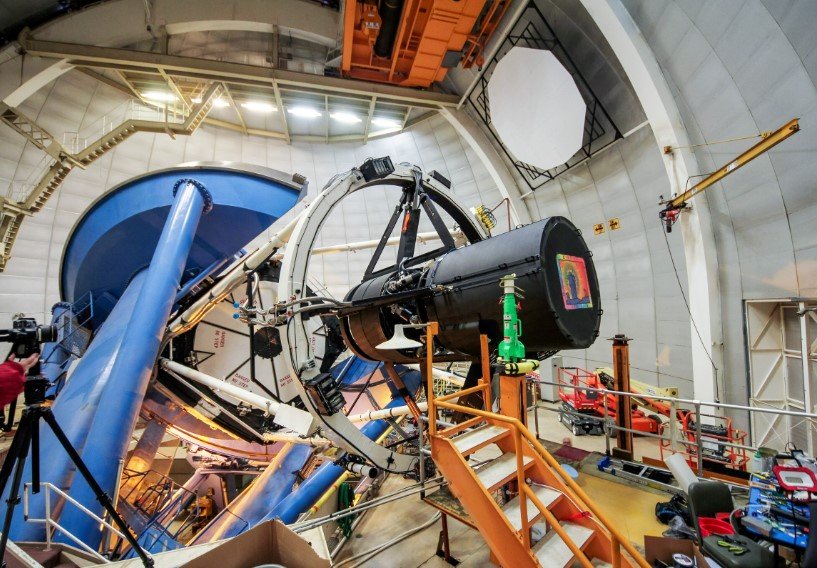A groundbreaking cosmic map has cracked open the door to something astronomers have only dared to speculate about — that dark energy, the invisible force accelerating the universe’s expansion, may be changing over time. And if that’s true, we might be standing on the edge of a serious rewrite of our understanding of the universe.
The map, created using the Dark Energy Spectroscopic Instrument (DESI), charts the positions of more than 15 million galaxies and quasars, spanning 11 billion years of cosmic history. It’s the biggest and most detailed 3D map of the universe ever made. And while it’s mesmerizing in its own right, it’s what the data suggests that has scientists buzzing — or perhaps quietly freaking out.
A Cosmic Instrument and a Big Surprise
Mounted atop the Mayall Telescope in Arizona’s Kitt Peak National Observatory, DESI was built to do one thing really well: collect light from distant galaxies and help us figure out how fast they’re moving away from us.
Researchers using DESI’s data noticed something strange. When they matched up DESI’s observations with other cosmic measurements — like the cosmic microwave background, supernovae data, and gravitational lensing — the numbers didn’t quite add up.
One possibility? Dark energy, which was thought to be constant, might actually be weakening.
“This finding suggests we may be on the brink of discovering entirely new physics beyond our current understanding,” said Ting Li of the University of Toronto, one of the scientists leading DESI’s Milky Way Survey.

Wait, Is the Universe Slowing Down?
Let’s rewind a bit. Dark energy makes up around 67% of the universe. It’s what’s pushing galaxies apart faster and faster — or so we thought.
But DESI’s data is making scientists rethink that story.
-
The map reaches a redshift of 1.6, meaning it’s capturing light from when the universe was just 4 billion years old.
-
Previously, surveys like BOSS/eBOSS only went up to redshift 1.1, or 5.5 billion years ago.
-
The farther back you look, the more you see dark energy’s supposed influence thinning out.
This suggests that, over time, dark energy may not have remained constant. If that’s the case, everything — from our cosmic models to how we think the universe might end — is up for debate.
Peeking Behind the Curtain of the Cosmos
“This is big,” said Tanveer Karim, a postdoc at the Dunlap Institute and a member of the DESI collaboration. “If dark energy really is evolving, then we don’t understand most of what makes up the universe.”
Now, take that in for a second. Scientists are openly saying that the majority of the universe might be more mysterious than they believed. That’s not just humbling — it’s slightly terrifying.
To give a clearer view of how far DESI pushes the envelope, here’s a quick comparison:
| Survey | Max Redshift | Universe Age at That Redshift |
|---|---|---|
| BOSS/eBOSS | 1.1 | 5.5 billion years |
| DESI | 1.6 | 4 billion years |
That’s a huge leap in cosmic time — and it’s part of what allows researchers to notice the potential dip in dark energy’s influence.
It’s Complicated… and Intriguing
No one is claiming discovery just yet. There’s a threshold for that in physics — the kind that demands more data, more agreement, and less statistical wiggle room.
But the signs are there, and they’re hard to ignore.
DESI’s own data doesn’t contradict the standard model on its own. But add in the other stuff — the early universe’s leftover light (CMB), exploding stars, and distorted light paths — and suddenly it’s like trying to make puzzle pieces fit into the wrong box.
That has scientists like Will Percival of the University of Waterloo scratching their heads: “It’s looking more and more like we may need to modify our standard model of cosmology.”
Could New Physics Be on the Horizon?
This isn’t just about tweaking numbers or redrawing graphs. If dark energy is evolving, then our most basic ideas about gravity, space, and time could be incomplete.
Some researchers suggest we could be witnessing a “phase transition” in dark energy, something akin to water freezing into ice or boiling into steam — except on a cosmic scale. That’s theoretical, of course. But the intrigue is real.
“We’re in the business of letting the universe tell us how it works,” said Andrei Cuceu from Berkeley Lab. “Maybe the universe is telling us it’s more complicated than we thought.”
And the stakes? Pretty huge. The fate of the universe depends on whether dark energy keeps accelerating things or slows down. That’s the difference between an eternal expansion, a slow freeze, or even a potential reversal in billions of years.
So What Happens Next?
This isn’t the end of the conversation. Far from it. Scientists will keep analyzing more data, looking for patterns, and trying to confirm whether dark energy really is changing.
Until then, DESI will keep scanning, mapping, and pushing the limits of what we know.
For now, the universe seems to be whispering that it has more secrets to tell. And finally, we’re getting close enough to hear.
